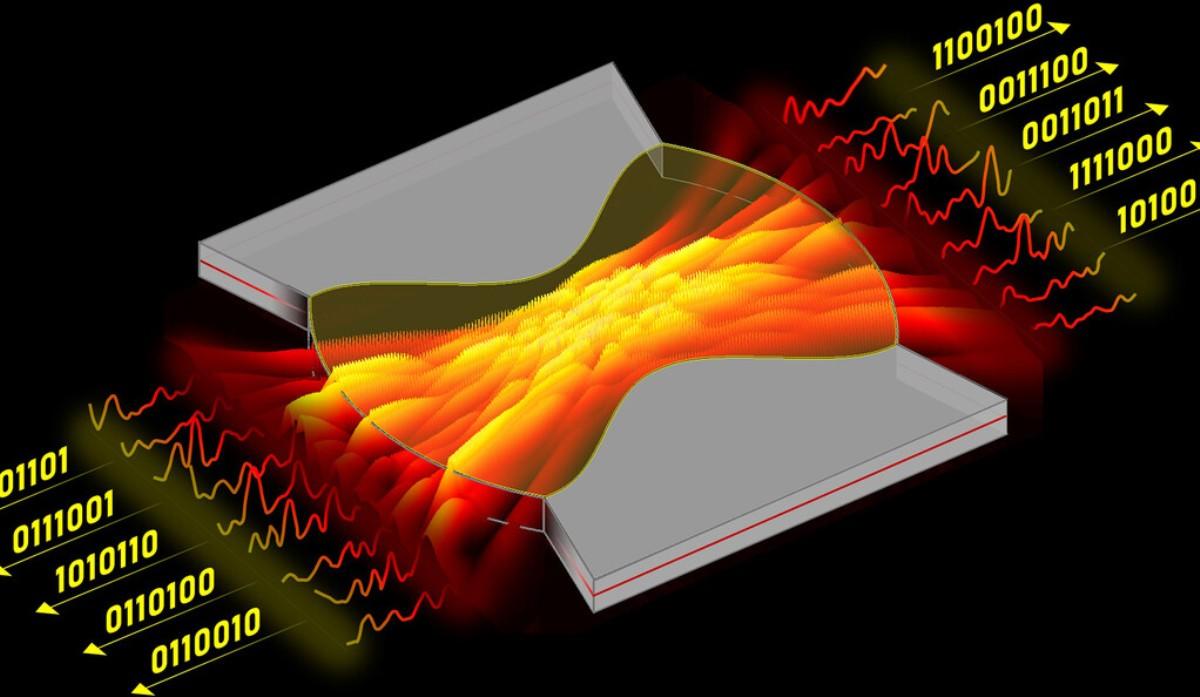
Scientists have built this ultrafast laser-powered random number generator

A new light-based system could be used to generate the cryptography keys that secure highly sensitive data and transactions.
Image: Kyungduk Kim/ University of Yale
Using a single, chip-scale laser, scientists have managed to generate streams of completely random numbers at about 100 times the speed of the fastest random-numbers generator systems that are currently in use.
The new system, which is described as “massively parallel ultrafast random bit generation,” could be used to generate the cryptography keys that secure highly sensitive data and transactions, which are currently at risk of attack from hackers armed with ever-increasing computer power.
Randomness has a fundamental role to play in cryptography: the more random a security key is, the harder it is to use logical mathematics to crack the code. This is why random numbers generators are used to encrypt data: the technology creates streams of bits that can in turn be used to produce very strong cryptography keys.
There are many ways to generate random numbers, the most well-known of which can be traced back over thousands of years: for instance, a simple dice, or coin-flipping, provide unpredictable results. This is what modern cryptography is attempting to emulate.
Of course, manual random number generation is incapable of keeping pace with the scale of demand for data security. To create large amounts of random numbers at scale, new technologies were developed to quickly translate into bits, or numbers, the unpredictable behavior of some natural phenomena.
Lasers, for example, are made of tiny quantum photons that behave in a chaotic, unpredictable manner – and the random fluctuations of the particles that make up a laser beam can be detected by a computer, to be translated into sequences of numbers that are completely non-deterministic.
Although the unpredictable properties of lasers have been used to generate random numbers before, those systems are limited. Laser-based systems aren’t capable of producing many numbers very fast, nor can they generate numbers simultaneously from a single beam.
“Usually, those physical random number generators are not very fast – that’s one problem,” said Hui Cao, professor of applied physics at Yale University, who led the study. “Also, they are sequential – that is, they usually just generate one bitstream. They cannot generate many bitstreams simultaneously. And in each stream, the rate is relatively low, so that prevents it from generating a lot of random numbers very quickly.”
At the same time, the need for a system that can produce random numbers at scale is fast increasing. As networks expand in an ever-connected way, it is becoming necessary to increase the generation rate of random numbers to keep pace with demand, and make sure that sensitive data is appropriately protected.
To improve the output of laser-based random number generators, Cao and her team created a compact single laser, and tweaked the design of the laser cavity to make it resemble an hourglass. When the laser is shined, light waves ricochet between either end of the hourglass, simultaneously resonating in the device; the fluctuations in the intensity of the quantum particles of light are recorded by a fast camera, to be translated by a computer into random series of numbers.
Thanks to the new design, therefore, the cavity acts as a resonator for the light waves, meaning that random bits can be generated in parallel, even with a single laser diode – a first, for light-based random number generators.
The results are promising, both in speed and scale: using the new amplifying system, Cao and her team generated about 250 terabits, or 250,000 gigabits, or random bits per second, which is more than two orders of magnitude higher than the fastest current systems. The researchers said that the technology can also be scaled up “significantly”.
“It really opens a new avenue on how to generate random numbers much faster, and we have not reached the limit yet,” said Cao. “As to how far it can go, I think there’s still a lot more to explore.”
For the technology to be ready for practical use, however, it will be necessary to create a compact chip that incorporates both the laser and the photodetectors that could directly and rapidly send measurements to computers in real-time.
With many companies looking at innovative ways to leverage light particles for random number generation, the field is likely to be busy in the next few years.
UK-based quantum company Nu Quantum, for example, is working on a device that can emit and detect quantum particles of light, called single photons. In the long term, Nu Photon’s founders hope that the technology will be used to build large-scale quantum computers; for now, however, the start-up is working with the National Physical Laboratory to commercialize the device for quantum random number generation.















